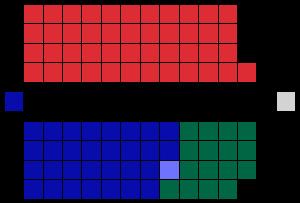1 May 1965 (1965-05-01) 1968 → 39 seats 54 seats 8 9 Start date May 1, 1965 | 17 July 1959 30 April 1964 47 seats 45 seats 49.82% 43.31% | |
 | ||
Winner Robert Askin | ||
The 1965 New South Wales state election was held on 1 May 1965. It was conducted in single member constituencies with compulsory preferential voting and was held on boundaries created at a 1961 redistribution. The election was for all of the 94 seats in the Legislative Assembly.
Contents
Issues
In May 1965, Labor had been in power for 24 years and 54-year-old Jack Renshaw, who had been seen as a generational change for the party leadership, had been premier for one year. However, Renshaw had difficulty adjusting to a televised campaign and his manner, the result of spending much of his early life in remote New South Wales, had not resonated with urban voters. The longevity of the government was an issue promoted by the opposition which described it as being composed of "tired old men"; indeed, six members of Renshaw's cabinet were 65 years old or older, and most of them had been in cabinet during Labor's entire 24-year run in government.
Continuing cost overruns and construction delays at the Sydney Opera House detracted from the government's economic management and accusations that the Speaker, Ray Maher, had indecently exposed himself to a staff member disrupted the start of the government's campaign. In addition, the government's keynote policy of releasing large tracts of land in Sydney for residential development was leaked to the opposition, which then claimed it as its own policy. Labor continued to have an ideological difficulty matching the Opposition's promises of state aid for non-government schools and this was the most decisive issue in the election. Other government policies included increased high school bursaries, measures to reduce unfair trading, reduced power costs, increased sick leave and reform of Workers' Compensation schemes.
In contrast to Labor the leader of the conservative coalition, Bob Askin, was skillful in his use of television and put forward a positive program. Promises for non-government schools included free transport, library grants, low interest loans, textbook subsidies and bursaries. Askin accused the state government of allowing the transport infrastructure of the state to decline and pledge his government to improve the Illawarra and Eastern Suburbs rail lines. He promised to integrate the state's bus and train fares and reduce suburban rail costs. Motor registry costs would be reduced and better rent control was to be introduced for pensioners Askin also promised to recruit more police and give more resources for mental health and district hospitals.
Results
Prior to the election, Independent Frank Purdue had gained the seat of Waratah from the Labor Party at a by-election caused by the death of Edward Greaves. Sam Jones regained the seat for Labor at the general election.
Despite a strong swing of more than 5% to the Coalition, the result of the election remained in doubt for two weeks. The effects of a long incumbency bolstered by the cumulative effects of a number of re-distributions limited Labor's losses to nine seats. In several of these the margin of defeat was less than 300 votes. In the final result the Coalition had 47 seats, one short of a majority. However, it could rely on the support of two conservative independents--Douglas Darby, a former Liberal who was subsequently readmitted to the party room, and Harold Coates, who had won the seat of Hartley. After providing a Speaker, the coalition was able to form a government with a three-seat majority in the Assembly, ending 24 years and eight terms of Labor government.
The DLP contested 28 seats and, while it gained less than 2.5% of the statewide primary vote, its preferences strongly favoured the coalition and were vital to its success. The Communist party was reduced to 13 candidates who received negligible support.
Seats changing party representation
This table lists changes in party representation since the 1965 election
Tabulated Results
1 There were 2,218,550 enrolled voters in 92 contested electorates and 38,018 were enrolled in 2 uncontested electorates (1 Labor, 1 Country).Aftermath
Robert Askin and Charles Cutler became Premier and Deputy Premier in New South Wales' first conservative government for 24 years. Renshaw became Leader of the Opposition, a post he held throughout the term of the parliament. During this parliament there were 3 by-elections. These resulted in the Country party gaining one seat from Labor and one seat from the Liberal Party.
